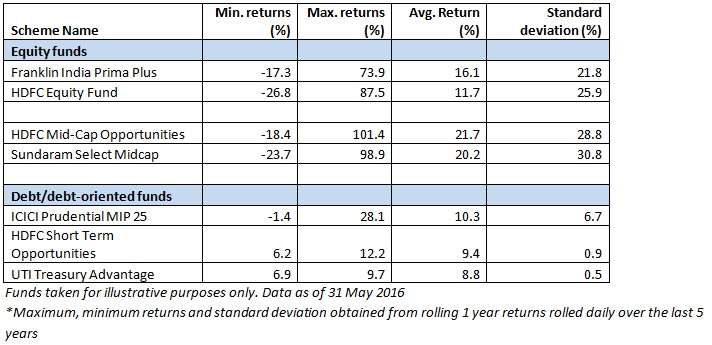Investors typically tend to pick a fund that has delivered the highest return in its category in the past. But can the past point-to-point performance of the fund be the only factor in your choice of funds? What if the fund under performed the year after you picked it?
While looking at the past performance of the fund is important, one also needs to look if the risks taken to achieve those returns were worth it. Rather than take very high risks in the hope of high returns (such risks can also result in steep falls) or settle for poor returns because of risk aversion, an investor can always have a balance between the two by going for funds with consistent performance. That is look for funds that do not have sharp swings in performance.
One of the several metrics to test consistency is standard deviation. Higher the standard deviation of a fund greater is its variation in returns from its mean. If you can get above-average returns with less volatility, chances are that you will build wealth optimally.
Standard deviation as a measure of volatility
If a fund can provide you above-category returns for lower volatility, it can provide stability to your portfolio.
The standard deviation of a fund needs to be seen in comparison with either its benchmark or its peer funds. If two funds perform similarly but one has a lower standard deviation, then the one that can deliver you similar returns for lower volatility is clearly preferable.
In general equity funds tend to have higher volatility and hence exhibit higher standard deviation compared with debt funds, as the former carries higher risks. There are also more factors at play that influence the equity market than the debt market. Besides, the relatively high liquidity in equity also results in more volatility in their prices.
Let us look at the table below to understand the standard deviation and the impact on returns.

Similarly, the mid-cap space, if you compare HDFC Mid-Cap Opportunities with Sundaram Select Midcap you will find the later losing out as a result of higher volatility (standard deviation).
Debt funds, on the other hand have delivered lower returns and have lower standard deviation. The deviation from the mean (whether it is maximum or minimum returns) is also not high.
Among those funds, you will see the MIP fund, which has small dose of equities has slightly higher standard deviation. The short-term debt fund is less volatile while the ultra-short fund (UTI Treasury Advantage) hardly has any volatility and is very stable. Of course, even within these funds, the deviation between them can vary but the difference is not as high as with equity funds.
While picking a fund in a particular category it is always a better idea to choose a fund with a lower standard deviation even if it comes at the cost of a few percentage points of lower performance, as long as the returns have been consistent and above category averages. The same logic can be applied while constructing a portfolio as well.








Thank you for so simplified explanation.
Kindly explain ‘Beta’ and ‘Sharpe Ratio’ and their implications with examples .
Wherfrom can we find such datas ?
We would certainly be doing a post these in the near future. You could find these data in the fund factsheets and various other websites as well.
Thank you for so simplified explanation.
Kindly explain ‘Beta’ and ‘Sharpe Ratio’ and their implications with examples .
Wherfrom can we find such datas ?
We would certainly be doing a post these in the near future. You could find these data in the fund factsheets and various other websites as well.
So, if I understood correctly, if the standard deviation of a fund is higher than, say, category average deviation, then this fund is volatile. In two funds of the same category, both giving above the average category (or similar) returns, the one with lower standard deviation is more stable fund. Lower the deviation, lower the volatility?
Yes Vijay, you have got it right.
So, if I understood correctly, if the standard deviation of a fund is higher than, say, category average deviation, then this fund is volatile. In two funds of the same category, both giving above the average category (or similar) returns, the one with lower standard deviation is more stable fund. Lower the deviation, lower the volatility?
Yes Vijay, you have got it right.